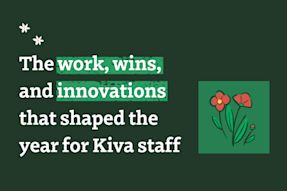We’re often told that we can each make a positive impact on the world, but many of us wonder how.
With so many worthy causes to support and people in need of help, it can be overwhelming to figure out where to direct our energy and our resources — especially when we’re feeling the crunch of inflation.
To get a better understanding of how people think about giving — whether it be money, time or emotional bandwidth — and what prevents them from doing so, Kiva commissioned a national, multi-generational survey* about how people give.
On behalf of Kiva, the Harris Poll asked 2,044 Americans 18 years and older of various backgrounds to answer a series of questions online about their giving habits and how they believe they can make a difference in the world.
The survey showed that while many Americans are worried about rising costs, they still care about others and want to make a positive impact on the world. Though they may believe they do not possess privilege or wealth, giving just a little can help alleviate stress and turn feelings of helplessness into action.
This is good news for Kiva lenders, who contribute small amounts to help underserved communities worldwide access the finance they need to thrive — and then are repaid, allowing them to multiply the impact that they have with each dollar.
Here are some of the key takeaways from the survey about how Americans think about giving — and how you, too, can help make a difference with just a little.
News makes an impact on altruism
Just like our diet affects our physical health, the information we take in influences our emotional state. Negative reports about climate change, political instability, economic insecurity and other bad news constantly cycling on our screens are affecting people’s emotions and their belief that their efforts have value.
Almost half of Americans (49%) reported that they feel angry reading or watching the news, and two out of three (66%) said seeing all the negative stories makes them want to stop paying attention to it altogether.
There were a few optimists in the bunch, however: One in five (21%) reported that they feel positive emotions when reading the news, including optimism, happiness and motivation to take action.
Black Americans were two times more likely to feel positively about the news than White and Hispanic participants and the only group to feel more optimistic (34%) than angry (31%).
When it comes to the belief in their ability to make a difference in the world, those with a little more life under their belts were more inclined to report that their confidence was low. 60% of millennials attribute bad news cycles with a lower confidence in their ability to make a difference in the world, with Gen Z being the least likely to report such discouragement (at 47%).
Even when the news is bad, it can inspire people to do good. Of the varying age groups, the youngest participants were by far and away more likely to feel motivated to take action in response to the news:
34% Gen Z (18-25 years)
21% Millennials (26-41 years)
20% Gen X (42-57 years)
18% Baby Boomers (58+ years)
Overall, an overwhelming majority (79%) of participants said that they believe individual actions can make a positive impact on the world.
Read more: ‘It never occurred to me how little money it would take to make a difference’
What keeps people from taking action?
Regardless of age or background, almost everyone encounters barriers that prevent them from donating money, researching an issue, or taking other actions that can make a difference.
For many, lack of money or time is the main obstacle. For others, there is also a sense of helplessness or a belief that no individual action can be truly effective. Kiva coined the term “broke altruism” to describe the desire to care for and help others, but feeling like you don’t have the resources.
Money is the most cited barrier, with 44% of poll participants reporting it as the number one factor keeping them from taking action. Gen Z felt this the most strongly at 45%, though 35% of Baby Boomers, arguably the wealthiest generational subsection, agreed.
But money isn’t the only obstacle people face in acting on their motivation. Feelings of helplessness and anxiety prevent 31% of Millenials and 27% of Gen Z participants from taking action, though this was reported as less of an issue for Gen X (19%) and Baby Boomers (10%) An average of 30% of total respondents reported they feel like no matter what they do, it won’t make a difference.
Not knowing how to get involved is also a barrier for younger generations, with 31% of Gen Z respondents reporting that it has prevented them from taking action to make a difference versus 15% of Baby Boomers.
What does “taking action” look like?
When it comes to deciding what, where, and how to make a difference in the world, those polled had a variety of insights.
Though many question their confidence in their capacity to impact the world in a positive way, only 21% of respondents think that individual actions have no impact at all.
In terms of effectiveness, educating oneself is considered to be the best action an individual can take, eliciting agreement from 50% of total respondents. An average of 30% reported that donating money is the most effective way to make a difference, though this opinion varied widely by generation:
37% Gen Z
33% Millennials
29% Baby Boomers
25% Gen X
Participants reported a variety of motivating influences to take action. Overall, they are more inclined to act due to a personal connection to a cause or issue versus other people’s social media posts or protests.
Respondents reported the following is what inspires them to take action:
41% - Being personally connected to a cause or issue
34% - Knowing someone impacted by a cause or issue
25% - Seeing friends or family members share on social media
20% - Posts by public figures or people they admire share on social media
16% - Seeing people protest in the street
15% - Posts influencers or public figures share on social media
Related: Kiva's volunteers make a difference by donating countless hours to review loans
Is giving only for the privileged?
Poll participants were asked to agree or disagree with the statement, “Donating is for privileged people.” While an average of two out of five (40%) agreed, the generational differences were significant:
57% of Millenials agreed, their perspective certainly informed by high student debts, multiple recessions, and the inability to achieve the same financial independence as their parents.
47% of Gen Z agreed, facing a future where higher education and employment can seem unattainable.
43% of Gen X agreed, the first generation to do worse financially than its predecessor.
27% of Baby Boomers agreed, having benefited from economic factors that helped create financial stability.
Across racial backgrounds, 50% of Black and 51% Hispanic Americans agreed that “donating is for privileged people.” By contrast, 37% of White respondents agreed.
Giving as stress relief
Even if they question whether it makes a difference, people still feel a sense of satisfaction around giving. When asked whether “donating money to a cause or organization helps relieve stress for me,” almost half (49%) of the total participants agreed.
Generationally, Millennials were the most likely (57%) to report giving as a stress reliever, followed by Gen X (51%) and Gen Z (49%.)
By far, the subsection that agreed most strongly with the statement were Black Americans at 64%, in contrast to their White (46%) and Hispanic (48%) counterparts.
Making a big difference with a little
At Kiva, it’s easy to make a difference with a small amount of money. With just $5 or more, people of all ages, from any background, can be a part of a team that helps make a difference in lives all over the globe. Making a loan to an individual can help them access the funds they need to start a business, grow their income, or improve their quality of life. With our crowdfunding model, many small contributions add up to a big impact. And since it’s a loan, it means that when repaid, it can be lent again and again, helping you make a bigger difference with each dollar.
Consider making a loan on Kiva today — and let us know if it provides a little stress relief.
*About the methodology
This survey was conducted online within the United States by The Harris Poll on behalf of Kiva from September 22-26, 2022 among 2,044 U.S. adults ages 18 and older. The sampling precision of Harris online polls is measured by using a Bayesian credible interval. For this study, the sample data is accurate to within +/- 2.8 percentage points using a 95% confidence level. For complete survey methodology, including weighting variables and subgroup sample sizes, please contact media@kiva.org.















